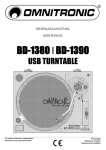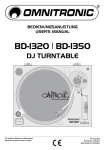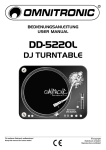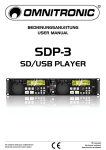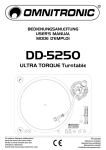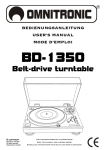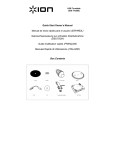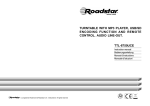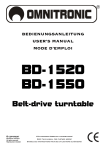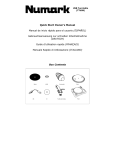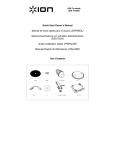Download Gemini DRT-1000
Transcript
BEDIENUNGSANLEITUNG USER MANUAL DRT-1000 RECORDING TURNTABLE Für weiteren Gebrauch aufbewahren! Keep this manual for future needs! © Copyright Nachdruck verboten! Reproduction prohibited! Inhaltsverzeichnis/ Table of contents 1. EINFÜHRUNG ............................................................................................................................................... 4 2. SICHERHEITSHINWEISE............................................................................................................................. 4 3. BESTIMMUNGSGEMÄSSE VERWENDUNG .............................................................................................. 5 4. GERÄTEBESCHREIBUNG........................................................................................................................... 6 4.1 Features ................................................................................................................................................... 6 4.2 Bedienelemente und Anschlüsse............................................................................................................. 7 5. MONTAGE UND GRUNDEINSTELLUNGEN............................................................................................... 8 5.1 Plattenteller montieren ............................................................................................................................. 8 5.2 Systemträger und Gegengewicht für den Tonarm montieren.................................................................. 9 5.3 Auflagegewicht einstellen......................................................................................................................... 9 5.4 Antiskating einstellen ............................................................................................................................... 9 5.5 Nadelbeleuchtung montieren ................................................................................................................. 10 6. ANSCHLÜSSE ............................................................................................................................................ 10 7. BEDIENUNG ............................................................................................................................................... 10 7.1 Schallplatte abspielen ............................................................................................................................ 10 7.2 USB-Geräte und Speicherkarten abspielen........................................................................................... 11 7.3 Tonaufnahmen ....................................................................................................................................... 11 8. REINIGUNG UND WARTUNG.................................................................................................................... 12 8.1 Transport................................................................................................................................................ 12 9. ZUBEHÖR ................................................................................................................................................... 12 9.1 Tonabnehmersystem und Abtastnadel ersetzen ................................................................................... 12 9.2 Ersatz-Systemträger .............................................................................................................................. 13 10. TECHNISCHE DATEN .............................................................................................................................. 13 1. INTRODUCTION ......................................................................................................................................... 14 2. SAFETY INSTRUCTIONS .......................................................................................................................... 14 3. OPERATING DETERMINATIONS.............................................................................................................. 15 4. DESCRIPTION ............................................................................................................................................ 16 4.1 Features ................................................................................................................................................. 16 4.2 Operating elements and connections .................................................................................................... 17 5. ASSEMBLY AND BASIC ADJUSTMENTS ............................................................................................... 18 5.1 Mounting the turntable platter ................................................................................................................ 18 5.2 Mounting the headshell and the counterweight for the tone arm........................................................... 19 5.3 Adjusting the stylus pressure ................................................................................................................. 19 5.4 Adjusting the anti-skating facility............................................................................................................ 19 5.5 Mounting the target light......................................................................................................................... 20 6. CONNECTIONS .......................................................................................................................................... 20 7. OPERATION ............................................................................................................................................... 20 7.1 Playing a record ..................................................................................................................................... 20 7.2 Playing USB devices and memory cards............................................................................................... 21 7.3 Audio recordings .................................................................................................................................... 21 8. CLEANING AND MAINTENANCE ............................................................................................................. 22 8.1 Transport................................................................................................................................................ 22 9. ACCESSORIES........................................................................................................................................... 22 9.1 Replacement phono cartridge system and stylus .................................................................................. 22 9.2 Replacement headshell.......................................................................................................................... 23 10. TECHNICAL SPECIFICATIONS............................................................................................................... 23 Diese Bedienungsanleitung gilt für die Artikelnummer: This user manual is valid for the article number: 10603062 10603062 Das neueste Update dieser Bedienungsanleitung finden Sie im Internet unter: You can find the latest update of this user manual in the Internet under: www.omnitronic.com BEDIENUNGSANLEITUNG Recording-Plattenspieler Lesen Sie vor der ersten Inbetriebnahme zur eigenen Sicherheit diese Bedienungsanleitung sorgfältig durch! Alle Personen, die mit der Aufstellung, Inbetriebnahme, Bedienung, Wartung und Instandhaltung dieses Gerätes zu tun haben, müssen - entsprechend qualifiziert sein - diese Bedienungsanleitung genau beachten - die Bedienungsanleitung als Teil des Produkts betrachten - die Bedienungsanleitung während der Lebensdauer des Produkts behalten - die Bedienungsanleitung an jeden nachfolgenden Besitzer oder Benutzer des Produkts weitergeben - sich die letzte Version der Anleitung im Internet herunter laden 1. EINFÜHRUNG Wir freuen uns, dass Sie sich für einen OMNITRONIC Plattenspieler entschieden haben. Wenn Sie nachfolgende Hinweise beachten, sind wir sicher, dass Sie lange Zeit Freude an Ihrem Kauf haben werden. Nehmen Sie das Gerät aus der Verpackung. Bitte überprüfen Sie vor der ersten Inbetriebnahme, ob kein offensichtlicher Transportschaden vorliegt. Sollten Sie Schäden an der Netzleitung oder am Gehäuse entdecken, nehmen Sie das Gerät nicht in Betrieb und setzen sich bitte mit Ihrem Fachhändler in Verbindung. 2. SICHERHEITSHINWEISE ACHTUNG! Seien Sie besonders vorsichtig beim Umgang mit gefährlicher Netzspannung. Bei dieser Spannung können Sie einen lebensgefährlichen elektrischen Schlag erhalten! Dieses Gerät hat das Werk in sicherheitstechnisch einwandfreiem Zustand verlassen. Um diesen Zustand zu erhalten und einen gefahrlosen Betrieb sicherzustellen, muss der Anwender unbedingt die Sicherheitshinweise und die Warnvermerke beachten, die in dieser Gebrauchsanweisung enthalten sind. Unbedingt lesen: Bei Schäden, die durch Nichtbeachtung dieser Bedienungsanleitung verursacht werden, erlischt der Garantieanspruch. Für daraus resultierende Folgeschäden übernimmt der Hersteller keine Haftung. 4/23 00048594.DOC, Version 1.0 Den Netzstecker immer als letztes einstecken. Vergewissern Sie sich, dass der Netzschalter auf „OFF“ steht, wenn Sie das Gerät ans Netz anschließen. Halten Sie das Gerät von Hitzequellen wie Heizkörpern oder Heizlüftern fern. Das Gerät darf nicht in Betrieb genommen werden, nachdem es von einem kalten in einen warmen Raum gebracht wurde. Das dabei entstehende Kondenswasser kann unter Umständen Ihr Gerät zerstören. Lassen Sie das Gerät solange uneingeschaltet, bis es Zimmertemperatur erreicht hat! Stellen Sie keine Flüssigkeitsbehälter, die leicht umfallen können, auf dem Gerät oder in dessen Nähe ab. Falls doch einmal Flüssigkeit in das Geräteinnere gelangen sollte, sofort Netzstecker ziehen. Lassen Sie das Gerät von einem qualifizierten Servicetechniker prüfen, bevor es erneut benutzt wird. Beschädigungen, die durch Flüssigkeiten im Gerät hervorgerufen wurden, sind von der Garantie ausgeschlossen. Der Aufbau entspricht der Schutzklasse II. Das Gerät ist schutzisoliert. Lassen Sie die Netzleitung nicht mit anderen Kabeln in Kontakt kommen! Seien Sie vorsichtig beim Umgang mit Netzleitungen und -anschlüssen. Fassen Sie diese Teile nie mit nassen Händen an! Vergewissern Sie sich, dass die anzuschließende Netzspannung nicht höher ist als auf dem Spannungswahlschalter eingestellt. Achten Sie darauf, dass die Netzleitung nicht gequetscht oder durch scharfe Kanten beschädigt werden kann. Überprüfen Sie das Gerät und die Netzleitung in regelmäßigen Abständen auf Beschädigungen. Gerät bei Nichtbenutzung und vor jeder Reinigung vom Netz trennen! Fassen Sie dazu den Netzstecker an der Griffläche an und ziehen Sie niemals an der Netzleitung! ACHTUNG: Endstufen immer zuletzt einschalten und zuerst ausschalten! Beachten Sie bitte, dass Schäden, die durch manuelle Veränderungen an diesem Gerät verursacht werden, nicht unter den Garantieanspruch fallen. Kinder und Laien vom Gerät fern halten! ACHTUNG: Zu hohe Lautstärken können das Gehör schädigen! Im Geräteinneren befinden sich keine zu wartenden Teile. Eventuelle Servicearbeiten sind ausschließlich dem autorisierten Fachhandel vorbehalten! 3. BESTIMMUNGSGEMÄSSE VERWENDUNG Der DRT-1000 ist ein riemengetriebener Plattenspieler mit integriertem Phono-Vorverstärker. Er ist speziell konzipiert für die hochwertige und komfortable Digitalisierung von analogen Vinyl-Schallplatten auf externen Datenträgern. Zur Aufnahme der Musik im MP3-Format mit 128 kBit/s und 44,1 kHz Abtastrate können USB-Geräte und SD(HC)-Speicherkarten verwendet werden. Der DRT-1000 kann auch zum Abspielen von Datenträgern mit Titeln im MP3-Format eingesetzt werden. Dieses Produkt ist für den Anschluss an 80 - 260 V AC, 50/60 Hz Wechselspannung zugelassen und wurde ausschließlich zur Verwendung in Innenräumen konzipiert. Vermeiden Sie Erschütterungen und jegliche Gewaltanwendung bei der Installierung oder Inbetriebnahme des Gerätes. Achten Sie bei der Wahl des Installationsortes darauf, dass das Gerät nicht zu großer Hitze, Feuchtigkeit und Staub ausgesetzt wird. Vergewissern Sie sich, dass keine Kabel frei herumliegen. Sie gefährden Ihre eigene und die Sicherheit Dritter! Die Umgebungstemperatur muss zwischen -5° C und +45° C liegen. Halten Sie das Gerät von direkter Sonneneinstrahlung (auch beim Transport in geschlossenen Wägen) und Heizkörpern fern. 5/23 00048594.DOC, Version 1.0 Die relative Luftfeuchte darf 50 % bei einer Umgebungstemperatur von 45° C nicht überschreiten. Dieses Gerät darf nur in einer Höhenlage zwischen -20 und 2000 m über NN betrieben werden. Nehmen Sie das Gerät erst in Betrieb, nachdem Sie sich mit seinen Funktionen vertraut gemacht haben. Lassen Sie das Gerät nicht von Personen bedienen, die sich nicht mit dem Gerät auskennen. Wenn Geräte nicht mehr korrekt funktionieren, ist das meist das Ergebnis von unsachgemäßer Bedienung! Reinigen Sie das Gerät niemals mit Lösungsmitteln oder scharfen Reinigungsmitteln, sondern verwenden Sie ein weiches und angefeuchtetes Tuch. Soll das Gerät transportiert werden, verwenden Sie bitte die Originalverpackung, um Transportschäden zu vermeiden. Der Serienbarcode darf niemals vom Gerät entfernt werden, da ansonsten der Garantieanspruch erlischt. Wird das Gerät anders verwendet als in dieser Bedienungsanleitung beschrieben, kann dies zu Schäden am Produkt führen und der Garantieanspruch erlischt. Außerdem ist jede andere Verwendung mit Gefahren, wie z. B. Kurzschluss, Brand, elektrischem Schlag, etc. verbunden. 4. GERÄTEBESCHREIBUNG 4.1 Features Riemengetriebener Plattenspieler mit Aufnahmefunktion und Phono-Vorverstärker • USB-Anschluss und SD-Steckplatz für die hochwertige und komfortable Digitalisierung von analogen VinylSchallplatten auf externen Datenträgern • Aufnahmeformat: MP3 (44,1 kHz, 128 kBit/s) • Aufnahmepegel einstellbar, mit Clip-LED • Wiedergabefunktion für MP3-Dateien • Integrierter Phono-Vorverstärker mit Line-Pegel-Ausgang • Drei Geschwindigkeiten (33 1/3, 45 und 78 U/min) • Schnellstart • Großer Start/Pause-Taster • Motor mit Rückwärtslauf abschaltbar • LED-Nadelbeleuchtung (steckbar) • Einstellbares Antiskating • Schockabsorbierende Stellfüße • Inkl. Tonabnehmersystem, Slipmat, Cinch-Kabel • Lieferung ohne Abdeckhaube 6/23 00048594.DOC, Version 1.0 4.2 Bedienelemente und Anschlüsse 1 USB-Anschluss USB-Anschluss (Typ A) zum Einstecken eines USBSpeichergeräts. 2 SD-Kartenschlitz 10 Tasten und Zur Titelwahl und zum schnellen Vor- und Rücklauf auf dem angewählten Datenträger. 11 Taste REC MODE/REC STOP Zum Einsetzen einer SD(HC)-Speicherkarte. 3 Taste Zum Umschalten zwischen Start und Pause für den Plattenteller. Kurzes Drücken aktiviert den Aufnahmemodus (LED blinkt) und langes Drücken beendet die Aufnahme (LED aus). 12 Umschalter AUDIO SELECT Zum Umschalten zwischen den Eingangsquellen USB, SD und Schallplatte für die Wiedergabe. Die LEDs zeigen Ihnen, welche Quelle angewählt ist. 4 Plattenteller 5 Nadellampe 13 Adapter für Single-Platten 6 Systemträger mit Tonabnehmersystem 14 Regler REC LEVEL 7 Tasten zur Wahl der Geschwindigkeit • für 33O U/min die linke Taste drücken, die LED über der Taste leuchtet (Grundeinstellung) • für 45 U/min die rechte Taste drücken, die LED über der Taste leuchtet • für 78 U/min beide Tasten gleichzeitig drücken, die LEDs über den Tasten leuchten 8 Taste REVERSE Zum Einstellen des Aufnahmepegels. Leuchtet die ClipLED auf, ist das Signal übersteuert. 15 Tonarm-Lift 16 Antiskating-Rad 17 Gegengewicht-Skala Zum Umschalten zwischen Vor- und Rückwärtslauf. 18 Gegengewicht für den Tonarm 9 Taste 19 Tonarm-Stütze mit Verriegelungshebel Zum Umschalten zwischen Wiedergabe und Pause für einen externen Datenträger und zum Starten einer Aufnahme. 20 Ein-/Ausschalter für den Motor 7/23 00048594.DOC, Version 1.0 21 Analoger Line-Ausgang 23 Netzschalter Analoger Audioausgang (Cinch, Links/Rechts) mit LinePegel zum Anschluss an Verstärker, Mischpulte bzw. andere Geräte mit Line-Pegel-Eingängen. Drücken Sie den Netzschalter, um das Gerät ein- und auszuschalten. 22 Netzanschluss Stecken Sie hier die beiliegende Netzleitung ein. 5. MONTAGE UND GRUNDEINSTELLUNGEN Der Plattenteller, der Systemträger und das Gegengewicht für den Tonarm sind einzeln verpackt, damit sie und der Plattenspieler beim Transport nicht beschädigt werden. Nach dem Auspacken lassen sich alle Teile ganz einfach montieren. Die Verpackung sollte für eventuelle Transporte aufgehoben werden. 5.1 Plattenteller montieren 1. Legen Sie den Gummiantriebsriemen um die Unterseite des Plattentellers (Abb.1). 2. Stellen Sie den Plattenspieler auf einer ebenen, waagerechten Fläche auf und stecken Sie dann den Plattenteller auf die Achse des Plattenspielers (Abb. 2). 3. Drehen Sie den Plattenteller von Hand, bis sich eines der Löcher im oberen rechten Drittel befindet und die Antriebsachse des Motors zu sehen ist. 4. Der Gummiantriebsriemen ist durch die Plattentellerlöcher zu sehen. Fassen Sie den Antriebsriemen und legen Sie ihn über die Antriebsachse (Abb. 3). 5. Legen Sie die beiliegende Slipmat auf den Plattenteller. 8/23 00048594.DOC, Version 1.0 5.2 Systemträger und Gegengewicht für den Tonarm montieren 1. Nehmen Sie den Systemträger aus einem der beiden seitlichen Styropor-Verpackungsteile heraus, stecken Sie ihn auf das vordere Ende des Tonarmes und sichern Sie ihn mit der Verriegelungsmutter (Abb. 4). 2. Nehmen Sie das Gegengewicht aus einem der beiden seitlichen Styropor-Verpackungsteile heraus und stecken Sie es auf das hintere Ende des Tonarmes, bis es einrastet. Anschließend wird mit dem Gegengewicht das Auflagegewicht genau eingestellt, mit dem die Abtastnadel auf der Schallplatte aufliegt (Abb. 5). Abb. 4 Systemträger montieren Abb. 5 Gegengewicht montieren 5.3 Auflagegewicht einstellen 1. 2. 3. 4. 5. 6. 7. 8. Entfernen Sie die Schutzkappe für die Abtastnadel. Stellen Sie den Antiskating-Drehknopf entgegen dem Uhrzeigersinn auf „0“. Stellen Sie den Hebel für den Tonarm-Lift in die vordere Position. Öffnen Sie den Verriegelungshebel für den Tonarm nach rechts. Fassen Sie den Tonarm am Griff an und führen Sie ihn vorsichtig bis kurz vor den Plattenteller, sodass er sich frei nach oben und unten bewegen lässt. Achtung! Lassen Sie die Nadel nirgends anstoßen. Führen Sie den Tonarm seitlich mit der linken Hand, damit die Nadel nicht am Plattenteller anstößt. Verdrehen Sie mit der rechten Hand das Gegengewicht so, dass der Tonarm genau waagerecht stehen bleibt und nicht nach oben oder unten schwingt (Abb. 6). • Schwingt der Tonarm nach oben, drehen Sie das Gegengewicht entgegen dem Uhrzeigersinn. • Schwingt der Tonarm nach unten, drehen Sie das Gegengewicht im Uhrzeigersinn. Legen Sie den Tonarm zurück auf die Tonarm-Halterung und sichern Sie ihn mit dem Verriegelungshebel. Am Gegengewicht befindet sich ein drehbarer, schwarzer Ring mit einer Skala. Die Markierungslinie auf dem Tonarm zeigt auf irgendeinen Wert der Skala. Drehen Sie den Ring auf Position „0“ ohne dabei das Gegengewicht zu verdrehen (Abb. 7). Die Skala gibt das Auflagegewicht in Gramm an. Für das mitgelieferte Abtastsystem ist ein Auflagegewicht von 3,5 g erforderlich. Drehen Sie dazu das Gegengewicht (mitsamt der Skala) entgegen dem Uhrzeigersinn, bis die Markierungslinie des Tonarms auf „3,5“ zeigt (Abb. 8). Wenn Sie ein anderes Abtastsystem verwenden stellen Sie das vom Hersteller angegebene Auflagegewicht ein. Abb. 6 Tonarm ausbalancieren Abb. 7 Skalenring Abb. 8 Auflagegewicht einstellen 5.4 Antiskating einstellen Beim Abspielen einer Schallplatte treten Kräfte an der Abtastnadel auf, welche durch die AntiskatingEinrichtung aufgehoben werden. Stellen Sie dazu den Antiskating-Drehknopf von „0“ auf den Wert, der dem Auflagegewicht gleich ist ein, d. h. bei dem mitgelieferten Abtastsystem auf „3,5“. Der Wert ist auf dem Drehknopf abzulesen. 9/23 00048594.DOC, Version 1.0 5.5 Nadelbeleuchtung montieren Nehmen Sie die Nadelbeleuchtung aus einem der beiden seitlichen Styropor-Verpackungsteile heraus und stecken Sie sie in die dafür vorgesehene Cinch-Buchse (Abb. 9). Die Nadelbeleuchtung wird automatisch mit Einschalten des Stroms aktiviert. Sie können die Lampe im Radius von 360° frei ausrichten. Achtung! An diese Buchse dürfen niemals andere Stecker, z. B. Mixereingänge etc. angeschlossen werden! Andernfalls Gefahr von irreparablen Schäden an Ihrem Equipment. Abb. 9 Nadelbeleuchtung einstecken 6. ANSCHLÜSSE Schalten Sie vor dem Anschließen oder Ändern bestehender Anschlüsse den Plattenspieler aus. 1. Verbinden Sie den analogen Audioausgang des Plattenspielers über das beiliegende Cinch-Kabel mit den Line-Pegel-Eingangsbuchsen am Verstärker oder Mischpult. Achten Sie darauf, dass die rechts/links Belegung (Steckerfarbe rot/weiß) an beiden Geräten übereinstimmt. 2. Verbinden Sie das beiliegende Netzkabel mit der entsprechenden Buchse am Plattenspieler und stecken Sie den Netzstecker in eine Steckdose. Das Gerät Produkt ist für den Anschluss an 80 - 260 V, 50/60 Hz Wechselspannung zugelassen. Wenn das Gerät direkt an das örtliche Stromnetz angeschlossen wird, muss eine Trennvorrichtung mit mindestens 3 mm Kontaktöffnung an jedem Pol in die festverlegte elektrische Installation eingebaut werden. Das Gerät darf nur an eine Elektroinstallation angeschlossen werden, die den VDE-Bestimmungen DIN VDE 0100 entspricht. Die Hausinstallation muss mit einem Fehlerstromschutzschalter (RCD) mit 30 mA Bemessungsdifferenzstrom ausgestattet sein. 7. BEDIENUNG 7.1 Schallplatte abspielen 1. Entfernen Sie die Schutzkappe für die Abtastnadel. 2. Schalten Sie den Plattenspieler mit dem Netzschalter ein. Die Nadellampe leuchtet. 3. Drücken Sie die entsprechende Taste zur Wahl der Geschwindigkeit. • für 33O U/min die linke Taste (Grundeinstellung) • für 45 U/min die rechte Taste • für 78 U/min beide Tasten gleichzeitig Zur Anzeige der gewählten Geschwindigkeit leuchtet die jeweilige LED über den Tasten. Bei 78 U/min leuchten beide LEDs. 4. Legen Sie die Schallplatte auf. Legen Sie bei Single-Platten den Adapter mit auf. 5. Öffnen Sie den Verriegelungshebel für den Tonarm nach rechts. Stellen Sie zum Anheben des Tonarms den Hebel für den Tonarm-Lift in die hintere Position. 6. Fassen Sie den Tonarm am Griff an und positionieren Sie die Abtastnadel über den Anfang bzw. die gewünschte Stelle auf der Schallplatte. Stellen Sie den Hebel für den Tonarm-Lift in die vordere Position. Der Tonarm senkt sich langsam auf die Schallplatte. . Der Plattenteller beginnt zu rotieren. Die Platte kann während des 7. Drücken Sie die Taste Abspielens für eine Unterbrechung mit der Taste an jeder Stelle gestoppt und wieder gestartet werden. 8. Mit der Taste MOTOR OFF stoppen Sie den Motor (rote Kontroll-LED erlischt). 10/23 00048594.DOC, Version 1.0 9. Mit der Taste REVERSE können Sie die Drehrichtung umschalten. Drücken Sie dazu jeweils kurz die Taste. Bei eingeschaltetem Rückwärtslauf leuchtet die rote Kontroll-LED. 10. Zum Beenden des Abspielens heben Sie den Tonarm mit dem Tonarm-Lift an und führen ihn per Hand zurück auf den Tonarm-Halter. Stoppen Sie den Plattenteller mit der Taste . 11. Sichern Sie nach dem Gebrauch des Plattenspielers den Tonarm mit dem Verriegelungshebel. 7.2 USB-Geräte und Speicherkarten abspielen 1. Stecken Sie USB-Geräte in den USB-Anschluss ein. Um eine Speicherkarte einzusetzen, schieben Sie sie mit den Kontakten nach unten und der abgeschrägten Ecke nach rechts soweit in den Kartenschlitz, bis sie einrastet. Um eine Speicherkarte auszugeben, drücken Sie diese leicht an woraufhin sie herausspringt und abgezogen werden kann. ACHTUNG! Entfernen Sie niemals USB-Geräte oder Speicherkarten im Wiedergabemodus, um Schäden oder Datenverlust zu vermeiden. Hinweise zu Speicherkarten und USB-Geräten • Das Gerät unterstützt SD- und SDHC-Speicherkarten. • Das Gerät unterstützt USB-Massenspeichergeräte der Kategorie „Mass Storage Class" (MSC) 1.0, 1.1, 2.0, einschließlich tragbare Flash-Memory-Geräte und digitale Audioplayer. Externe Festplattenlaufwerke, optische Speicher wie externe CD/DVD-Lauwerke und USB-Geräte, die an einem USB-Verteiler angeschlossen sind, werden jedoch nicht erkannt. • Bei Verwendung von bestimmten USB-Geräten ist u.U. keine einwandfreie Wiedergabe möglich. • Wird ein Datenträger mit einer großen Anzahl von Ordnern und Dateien eingesetzt, kann der Einlesevorgang längere Zeit beanspruchen. 2. Drücken Sie den Umschalter AUDIO SELECT, um von Schallplatte auf ein USB-Gerät oder eine Speicherkarte umzuschalten. Mit dem ersten Tastendruck wird der USB-Anschluss angewählt, mit dem nächsten der SD-Kartenschlitz und mit dem nächsten schalten Sie zurück auf Schallplatte. Die LEDs zeigen Ihnen durch Leuchten, welche Quelle aktiviert ist. Beim Einlesevorgang von USB-Geräten und Speicherkarten blinkt die entsprechende LED. , um die Wiedergabe zu starten. Durch Drücken der Taste wird die 3. Drücken Sie die Taste Wiedergabe unterbrochen und durch erneutes Drücken wieder gestartet. 4. Mit den Tasten und wählen Sie Titel an und aktivieren den schnellen Vor- und Rücklauf. Mit jedem Drücken der Taste wird ein Titel vorgesprungen. Durch Drücken der Taste wird an den Titelanfang gesprungen und mit jedem weiteren Drücken ein Titel zurück. Für den schnellen Vorlauf halten Sie die Taste gedrückt, für den schnellen Rücklauf die Taste . 7.3 Tonaufnahmen 1. Schalten Sie mit dem Umschalter AUDIO SELECT auf Schallplatte (LED PHONO leuchtet). 2. Drücken Sie kurz die Taste REC MODE/REC STOP, um den Aufnahmemodus zu aktivieren (die zugehörige LED blinkt). Ist für die Aufnahme ein USB-Gerät angeschlossen, blinkt die LED USB und zeigt, dass das Gerät angewählt ist. Bei einer Speicherkarte blinkt die LED SD. Wenn sowohl ein USBGerät als auch eine Speicherkarte eingesetzt ist, wird automatisch das USB-Gerät als Aufnahmemedium angewählt. . Die Aufnahme wird gestartet. Auf dem Aufnahmemedium wird ein Ordner mit 3. Drücken Sie die Taste der Aufnahme im MP3-Format mit 128 kBit/s und 44,1 kHz Abtastrate angelegt. 4. Stellen Sie mit dem Regler REC LEVEL den Aufnahmepegel ein. Die Übersteuerungsanzeige REC CLIP sollte gar nicht bzw. bei Signalspitzen nur ganz kurz aufleuchten. Leuchtet sie permanent, muss der Pegel entsprechend gesenkt werden. 5. Halten Sie die Taste REC MODE/REC STOP etwa drei Sekunden gedrückt, um die Aufnahme zu beenden. Die LED der Taste REC MODE/REC STOP erlischt und die LED des Aufnahmemediums hört auf zu blinken. Tipp Zum Bearbeiten der Aufnahmen an einem Computer sind verschiedene Programme als Freeware im Internet erhältlich. Wir empfehlen Ihnen den leicht zu bedienenden Audioeditor Audacity (http://audacity.sourceforge.net/). 6. Schalten Sie das Gerät nach dem Gebrauch mit dem Netzschalter aus. 11/23 00048594.DOC, Version 1.0 8. REINIGUNG UND WARTUNG LEBENSGEFAHR! Vor Wartungsarbeiten unbedingt allpolig vom Netz trennen! Der Plattenspieler sollte regelmäßig von Verunreinigungen wie Staub usw. gereinigt werden. Verwenden Sie zur Reinigung ein fusselfreies, angefeuchtetes Tuch. Auf keinen Fall Alkohol oder irgendwelche Lösungsmittel zur Reinigung verwenden! Verwenden Sie zum Entstauben der Abtastnadel und Schallplatten eine Carbonfaser-Plattenbürste (z.B. Artikel 10608985 Carbonfaser-Plattenreinigungsbürste). Im Geräteinneren befinden sich keine zu wartenden Teile. Wartungs- und Servicearbeiten sind ausschließlich dem autorisierten Fachhandel vorbehalten! Sollten einmal Ersatzteile benötigt werden, verwenden Sie bitte nur Originalersatzteile. Sollten Sie noch weitere Fragen haben, steht Ihnen Ihr Fachhändler jederzeit gerne zur Verfügung. 8.1 Transport Soll der Plattenspieler transportiert werden, sichern Sie bitte alle Bauteile des Gerätes in der Originalverpackung, um Transportschäden zu vermeiden. 1. Stecken Sie die Schutzkappe für die Abtastnadel auf. 2. Sichern Sie den Tonarm mit dem Verriegelungshebel. 3. Schrauben Sie das Gegengewicht für den Tonarm durch Drehen im Uhrzeigersinn ab verpacken Sie es separat und transportgesichert. 4. Nehmen Sie den Plattenteller von der Achse und verpacken Sie ihn separat und transportgesichert. 5. Verwenden Sie bitte die Originalverpackung für Transporte. 9. ZUBEHÖR 9.1 Tonabnehmersystem und Abtastnadel ersetzen Bei Bedarf kann das Tonabnehmersystem oder die Abtastnadel leicht ausgewechselt werden. Entsprechende Ersatzteile sind im Fachhandel erhältlich, z. B. das Tonabnehmersystem S-15 und die dazu passende Abtastnadel S-15 von OMNITRONIC. 1. Ziehen Sie zum Wechseln der Abtastnadel die Nadelhalterung nach vorne ab. Stecken Sie die neue Nadel auf das Abtastsystem. 2. Schrauben Sie zum Wechseln des Tonabnehmersystems den Systemträger vom Tonarm ab. 3. Ziehen Sie das Tonabnehmersystem vom Träger ab und ziehen Sie die Anschlussdrähte ab. 4. Schrauben Sie das neue Tonabnehmersystem am Träger fest und stecken Sie die Drähte wie folgt auf: weiß blau rot grün linker Kanal Pluspol linker Kanal Minuspol rechter Kanal Pluspol rechter Kanal Minuspol 5. Für ein optimales Abtasten sollte der Überhang – der Abstand zwischen Nadel und der Achse des Plattentellers – auf 15 mm eingestellt sein. Vergewissern Sie sich, dass das System mittig sitzt (korrekter Azimut) und die Schrauben angezogen sind (Abb. 10). 12/23 00048594.DOC, Version 1.0 6. Stellen Sie nach dem Austausch des Tonabnehmersystems das Auflagewicht und den Antiskating-Wert neu ein (Kapitel 5.3, 5.4). Abb. 10 Einstellen des Azimut 9.2 Ersatz-Systemträger Ein Ersatz-Systemträger (z. B. der Systemträger S-15 von OMNITRONIC) komplett mit einem Tonabnehmersystem ermöglicht bei Bedarf einen schnellen Austausch. Der Systemträger lässt sich einfach durch Ab- und Anschrauben auswechseln. Stellen Sie anschließend das Auflagewicht und den Antiskating-Wert neu ein (Kapitel 5.3, 5.4). 10. TECHNISCHE DATEN Spannungsversorgung: Gesamtanschlusswert: Typ: Antriebsart: Motor: Plattenteller: Drehzahl: Drehzahlübergang: Startzeit: Bremszeit: Gleichlaufschwankungen: Tonarm: Antiskating-Bereich: Auflagegewicht des Abtastsystems: Passendes Abtastsystem: Ausgänge: Geeignete Datenträger: Aufnahmeformat: Maße (LxBxH): Gewicht: 80 - 260 V AC, 50/60 Hz ~ 8W Manueller Plattenspieler Riemenantrieb Gleichstrommotor Ø 330 mm, Alu-Druckguss 33 1/3 U/min, 45 U/min und 78 U/min <1 s <1 s <1 s <0,2 % WRMS S-förmig mit Kardanaufhängung 0-4 g 3-4 g 6 - 10 g Stereo-Cinch mit Line-Pegel USB-Geräte und SD(HC)-Karten MP3 mit 128 kBit/s und 44,1 kHz Abtastrate 485 x 370 x 140 mm 4 kg Bitte beachten Sie: Technische Änderungen ohne vorherige Ankündigung und Irrtum vorbehalten. 11.08.2009 © 13/23 00048594.DOC, Version 1.0 OPERATING INSTRUCTIONS Recording Turntable CAUTION! Keep this device away from rain and moisture! Unplug mains lead before opening the housing! For your own safety, please read this user manual carefully before you initially start-up. Every person involved with the installation, operation and maintenance of this device has to - be qualified - follow the instructions of this manual - consider this manual to be part of the total product - keep this manual for the entire service life of the product - pass this manual on to every further owner or user of the product - download the latest version of the user manual from the Internet 1. INTRODUCTION Thank you for having chosen an OMNITRONIC turntable. If you follow the instructions given in this manual, we can assure you that you will enjoy this device for many years. Unpack your turntable. Please make sure that there are no obvious transport damages. Should you notice any damages on the A/C connection cable or on the casing, do not take the device into operation and immediately consult your local dealer. 2. SAFETY INSTRUCTIONS CAUTION! Be careful with your operations. With a dangerous voltage you can suffer a dangerous electric shock when touching the wires! This device has left our premises in absolutely perfect condition. In order to maintain this condition and to ensure a safe operation, it is absolutely necessary for the user to follow the safety instructions and warning notes written in this user manual. Important: Damages caused by the disregard of this user manual are not subject to warranty. The dealer will not accept liability for any resulting defects or problems. 14/23 00048594.DOC, Version 1.0 Always plug in the power plug least. Make sure that the power switch is set to OFF position before you connect the device to the mains. Keep away from heaters and other heating sources! If the device has been exposed to drastic temperature fluctuation (e.g. after transportation), do not switch it on immediately. The arising condensation water might damage your device. Leave the device switched off until it has reached room temperature. Never put any liquids on the device or close to it. Should any liquid enter the device nevertheless, disconnect from mains immediately. Please let the device be checked by a qualified service technician before you operate it again. Any damages caused by liquids having entered the device are not subject to warranty! This device falls under protection-class II and features a protective insulation. Never let the power cord come into contact with other cables! Handle the power cord and all connections with the mains with particular caution! Make sure that the power cord is never crimped or damaged by sharp edges. Check the device and the power cord from time to time. Always disconnect from the mains, when the device is not in use or before cleaning it. Only handle the power cord by the plug. Never pull out the plug by tugging the power cord. CAUTION: Turn the amplifier on last and off first! Please note that damages caused by manual modifications on the device or unauthorized operation by unqualified persons are not subject to warranty. Keep away children and amateurs! CAUTION: High volumes can cause hearing damage! There are no serviceable parts inside the device. Maintenance and service operations are only to be carried out by authorized dealers. 3. OPERATING DETERMINATIONS The DRT-1000 is a belt drive turntable with built-in phono preamplifier and has been specially designed for high-quality and convenient digitization of analog vinyl records to external data carriers. For audio recordings in the MP3 format with 128 kbit/s and 44.1 kHz sampling rate, USB devices and SD(HC) memory cards may be used. The DRT-1000 also serves for playing titles in the MP3 format from data carriers. This product is allowed to be operated with an alternating current of 80 - 260 V AC, 50/60 Hz and was designed for indoor use only. Do not shake the device. Avoid brute force when installing or operating the device. When choosing the installation spot, please make sure that the device is not exposed to extreme heat, moisture or dust. There should not be any cables lying around. You endanger your own and the safety of others! The ambient temperature must always be between -5° C and +45° C. The relative humidity must not exceed 50 % with an ambient temperature of 45° C. This device must only be operated in an altitude between -20 and 2000 m over NN. Operate the device only after having familiarized with its functions. Do not permit operation by persons not qualified for operating the device. Most damages are the result of unprofessional operation! 15/23 00048594.DOC, Version 1.0 Never use solvents or aggressive detergents in order to clean the device! Rather use a soft and damp cloth. Please use the original packaging if the device is to be transported. Never remove the serial barcode from the device as this would make the guarantee void. If this device will be operated in any way different to the one described in this manual, the product may suffer damages and the guarantee becomes void. Furthermore, any other operation may lead to dangers like shortcircuit, burns, electric shock, etc. 4. DESCRIPTION 4.1 Features Belt drive turntable with recording function and phono preamplifier • USB port and SD card slot for high-quality and convenient digitization of analog vinyl records to external data carriers • Recording format: MP3 (44.1 kHz, 128 kbit/s) • Recording level adjustable, with clip LED • Playback of MP3 files • Built-in phono preamplifier with line level outputs • 3 speeds (33 1/3, 45 and 78 RPM) • Quick start • Large start/pause button • Motor with reverse run can be switched off • Plug-in LED target lamp • Adjustable anti-skating • Shock-absorbing feet • Including pick-up system, slipmat, RCA cable • Delivery without dust cover 16/23 00048594.DOC, Version 1.0 4.2 Operating elements and connections 1 USB port 10 Buttons USB port (type A) for inserting a USB storage device. and For selecting titles and for fast forward and reverse on the selected data carrier. 2 SD card slot Slot for inserting an SD(HC) card. 11 Button REC MODE/REC STOP 3 Button To switch between start and pause for the platter. Short actuation of the button activates the recording mode (LED will be flashing) and long actuation stops the recording (LED off). 4 Platter 12 Selector switch AUDIO SELECT 5 Target light For switching between the input sources USB, SD and phono for playback. The LEDs will verify which source is active. 6 Headshell with phono cartridge system 13 Adaptor for single records 7 Buttons to select speed • for 33O RPM press the left button, the LED above the button lights (basic setting) • for 45 RPM press the right button, the LED above the button lights • for 78 RPM press both buttons simultaneously, the LEDs above the buttons light 8 Button REVERSE 14 Control REC LEVEL For adjusting the recording level. If the clip LED lights up, the signal is overloaded. 15 Tone arm lift 16 Anti-skating adjustment To switch between forward and reverse run. 17 Counterweight scale 9 Button 18 Counterweight for the tone arm To switch between play and pause for an external data carrier and to start a recording. 19 Tone arm rest with locking lever 20 On/off switch for the motor 17/23 00048594.DOC, Version 1.0 21 Analog line output Analog audio output (RCA, left/right) with line level for connecting an amplifier, a mixer or other units with line level inputs. 23 Power switch Press the power switch to turn the unit on and off. 22 Power input Plug in the supplied power cable here. 5. ASSEMBLY AND BASIC ADJUSTMENTS The headshell, the turntable platter and the counterweight for the tone arm are separately packed to prevent damage to the turntable during transportation. After unpacking, the parts can be easily assembled. The packing material should be kept for transportation purposes. 5.1 Mounting the turntable platter 1. Place the rubber driving belt over the bottom of the platter (Fig. 1). 2. Set up the turntable on a plane, stable ground and place the turntable platter on the axle of the turntable (Fig. 2). 3. Turn the platter by hand until one of the cutouts is near the top right corner and the driving axle of the motor is visible. 4. The rubber driving belt is visible through the cutouts of the turntable platter. Seize the driving belt and place it over the driving axle (Fig. 3). 5. Place the supplied slipmat on the turntable platter. 18/23 00048594.DOC, Version 1.0 5.2 Mounting the headshell and the counterweight for the tone arm 1. Take the headshell out of one of the two lateral polystyrene wrappings, place it onto the front end of the tone arm, and secure it with the locking nut (Fig. 4). 2. Take the counterweight out of one of the two lateral polystyrene wrappings and place it on the rear end of the tone arm until it locks into the place. The counterweight is then used for precise adjustment of the stylus pressure on the record (Fig. 5). Fig. 4 Mounting the headshell Fig. 5 Mounting the counterweight 5.3 Adjusting the stylus pressure 1. 2. 3. 4. 5. 6. 7. 8. Pull down the protective cap of the stylus. Turn the anti-skating knob counterclockwise to “0”. Place the lever for the tone arm lift in the front position. Open the tone arm locking lever to the right. Seize the handle of the tone arm and lead it carefully just before the turntable platter so that it can be moved upwards and downwards. Attention! The stylus must not hit against anything. Lead the tone arm with the left hand to the side so that the stylus does not hit against the turntable platter. With the right hand turn the counterweight so that the tone arm remains exactly in a horizontal position and does not move upwards or downwards (Fig. 6). • If the tone arm moves upwards, turn the counterweight counterclockwise. • If the tone arm moves downwards, turn the counterweight clockwise. Put the tone arm back onto the tone arm support and secure it with the locking lever. The counterweight is provided with a black rotary ring with a scale. The marking line on the tone arm points to a value on this scale. Without turning the counterweight, only turn the ring to “0” (Fig. 7). The scale indicates the stylus pressure in grams. A stylus pressure of 3.5 g is required for the supplied stylus system. For this purpose, turn the counterweight (with the scale) counterclockwise until the marking line on the tone arm points to “3.5” (Fig. 8). For other stylus systems adjust the stylus pressure indicated by the manufacturer. Fig. 6 Tone arm balance Fig. 7 Scale ring Fig. 8 Stylus pressure adjustment 5.4 Adjusting the anti-skating facility When playing a record, forces occur on the stylus which are compensated by the anti-skating facility. For this purpose, adjust the anti-skating knob from “0” to the value which equals the stylus pressure, i.e. for the supplied stylus system to “3.5”. The value is indicated on the knob. 19/23 00048594.DOC, Version 1.0 5.5 Mounting the target light Take the target light out of one of the two lateral polystyrene wrappings and plug it into the corresponding RCA jack (Fig. 9). The target light activates automatically when switching on the power. Adjust the light freely in a range of 360°. Caution! Never connect any other plugs, e.g. mixer inputs etc. to this jack! Otherwise, danger of heavy equipment damage. Fig. 9 Connecting the target light 6. CONNECTIONS Prior to connecting or changing existing connections switch off the turntable. 1. Connect the analog audio output of the turntable with the supplied RCA cable to the line level input jacks at the amplifier or mixer. Make sure that the right/left occupation (plug color red/white) is the same at both units. 2. Connect the supplied power supply cable to the corresponding input of the turntable and the mains plug to a power outlet. The unit is allowed to be operated with an alternating current of 80 - 260 V, 50/60 Hz. If the device will be directly connected with the local power supply network, a disconnection switch with a minimum opening of 3 mm at every pole has to be included in the permanent electrical installation. The device must only be connected with an electric installation carried out in compliance with the IEC standards. The electric installation must be equipped with a Residual Current Device (RCD) with a maximum fault current of 30 mA. 7. OPERATION 7.1 Playing a record 1. Remove the protective cover of the stylus. 2. Switch on the turntable with the power switch. The target light lights up. 3. To select the speed, press the corresponding button: • for 33O RPM the left button (basic setting) • for 45 RPM the right button • for 78 RPM both buttons simultaneously To indicate the selected speed, the corresponding LED above the buttons lights up. For 78 RPM both LEDs light up. 4. Put on the record. For single records, use the adaptor. 5. Open the locking lever for the tone arm to the right. To lift the tone arm, place the lever for the tone arm lift to the rear position. 6. Seize the handle of the tone arm, and place the stylus above the beginning or the desired spot on the record. Place the lever for the tone arm lift to the front position. The tone arm is slowly lowered onto the record. . The turntable platter starts to rotate. While playing, the record can be 7. Press the start/pause button stopped at any place and be restarted with the button . 8. To stop the motor press the button MOTOR OFF (red control LED extinguishes). 9. With the button REVERSE you can switch over the sense of rotation. For this purpose shortly press the button. With the reverse run switched on, the red control LED lights up. 10. To stop the playing, lift the tone arm with the tone arm lift and put it back onto the tone arm support by hand. Stop the turntable platter with the button . 11. After use of the turntable, secure the tone arm with the locking lever. 20/23 00048594.DOC, Version 1.0 7.2 Playing USB devices and memory cards 1. Insert USB devices into the USB port. Insert a memory card with the contacts pointing downwards and the notched corner to the right so far into the card slot until it is engaged. To eject a memory card, slightly press it into the slot until it comes out and can be removed. CAUTION! Never attempt to remove USB devices or memory cards in play mode. Otherwise damage or loss of data may occur. Regarding memory cards and USB storage devices • This unit supports SD and SDHC memory cards. • This unit supports MSC (Mass Storage Class) USB storage devices 1.0, 1.1, 2.0 including external portable flash memory devices and digital audio players. However, hard discs, optical discs such as external CD/DVD drives, and USB devices connected to a USB hub will not be recognized. • Depending on the device used, proper playback may not be possible with all USB storage devices. • When inserting a data carrier with a large number of folders and files, some time may be required to read in the contents. 2. Press the selector switch AUDIO SELECT to switch from the record to a USB device or a memory card. The unit must be in pause mode. The first actuation of the button will select the USB port, the next actuation will select the SD card slot and the next actuation will switch the unit back to the record. The LEDs will light to verify which source is active. During the read-in of a USB device or memory card the corresponding LED will be flashing. to start playback. By pressing the button playback can be interrupted and 3. Press the button restarted by pressing the button again. 4. For selecting titles and for fast forward/reverse use the buttons and . Each time the button is pressed, the unit will advance one title. By pressing the button , the unit will go to the beginning of the title and with each further actuation, the unit will go back another title. For fast forward, keep the button pressed, for fast reverse keep the button pressed. 7.3 Audio recordings 1. Switch to phono with the selector switch AUDIO SELECT (LED PHONO lights). 2. Shortly actuate the button REC MODE/REC STOP to activate the recording mode (the corresponding LED will be flashing). If a USB device is connected for the recording, the LED USB will be flashing to indicate that the device is selected. For a memory card, the LED SD will be flashing. If both a USB and a memory card is inserted, the USB device is automatically selected as memory medium. . The recording starts. On the memory medium, a new folder will be created with the 3. Press the button recording in the MP3 format with 128 kbit/s and 44.1 kHz sampling rate. 4. With the control REC LEVEL adjust the recording level. The overload indication REC CLIP should not light up or only light up shortly during signal peaks. If it lights permanently, reduce the level correspondingly. 5. To stop the recording, keep the button MODE/REC STOP pressed for about three seconds. The LED of the button REC MODE/REC STOP extinguishes and the LED of the memory medium stops flashing. Hint For processing the recordings on a computer, different programs are available as freeware on the internet. We recommend the easy-to-use audio editor Audacity (http://audacity.sourceforge.net/). 6. After use, switch off the unit with the power switch. 21/23 00048594.DOC, Version 1.0 8. CLEANING AND MAINTENANCE DANGER TO LIFE! Disconnect from mains before starting maintenance operation! We recommend a frequent cleaning of the turntable. Please use a soft lint-free and moistened cloth. Never use alcohol or solvents! For dusting the stylus and the records, use a carbon fiber brush for records (e.g. item 10608985 carbon fibber brush). There are no serviceable parts inside the device. Maintenance and service operations are only to be carried out by authorized dealers. Should you need any spare parts, please use genuine parts. Should you have further questions, please contact your dealer. 8.1 Transport For dispatching the turntable pay attention that all components of the unit are only packed in their original packing material and/or are especially secured for transportation. 1. Place the protective cap on the stylus. 2. Secure the tone arm with the locking lever. 3. Unscrew the counterweight for the tone arm by turning it clockwise and pack it separately and secured for transportation. 4. Remove the turntable platter from the axle and pack it separately and secured for transportation. 5. Please use the original packing box. CH 9. ACCESSORIES 9.1 Replacement phono cartridge system and stylus If required, the phono cartridge system or the stylus can easily be replaced. The corresponding replacement parts are available from the retailer, e. g. the magnetic phono cartridge system S-15 and the matching stylus S-15 from OMNITRONIC. 1. To change the stylus, pull off the stylus support in forward direction. Put the new stylus on the stylus system. 2. To change the phono cartridge system, screw off the headshell from the tone arm. 3. Screw off the phono cartridge system from the support and pull off the connection wires. 4. Tightly screw the new phono cartridge system on the support and put on the wires as follows: white left channel positive pole blue left channel negative pole red right channel positive pole green right channel negative pole 5. For optimized pick-up the overhang – the distance between the stylus and the axle of the turntable – should be set to 15 mm. Make sure that the system is centered (correct azimuth) and the screws are fixed (Fig. 10). 6. After replacing the phono cartridge system, readjust the stylus pressure and the anti-skating value (chapters 5.3 and 5.4). Fig. 10 Adjusting the azimuth 22/23 00048594.DOC, Version 1.0 9.2 Replacement headshell A replacement headshell (e. g. the headshell S-15 from OMNITRONIC) including a phono cartridge system allows an immediate replacement, if required. The headshell can easily be replaced by unscrewing the existing one and screwing on the new one. After the replacement readjust the stylus pressure and the antiskating value (chapters 5.3 and 5.4). 10. TECHNICAL SPECIFICATIONS Power supply: Power consumption: Type: Drive method: Motor: Platter: Speed: Change time between speeds: Start time: Stop time: Wow and flutter: Tone arm: Anti-skating range: Stylus pressure range: Applicable cartridge weight: Output connectors: Available data carriers: Recording format: Dimensions: Weight: 80 - 260 V AC, 50/60 Hz ~ 8W manual turntable belt drive DC motor Ø 330 mm, aluminum diecast 33 1/3 RPM, 45 RPM, and 78 RPM <1 sec <1 sec <1 sec <0.2 % WRMS S-shape with Cardan's suspension 0-4 g 3-4 g 6 - 10 g stereo RCA with line level USB devices and SD(HC) cards MP3 with 128 kbit/s and 44.1 kHz sampling rate 485 x 370 x 140 mm 4 kg Please note: Every information is subject to change without prior notice. 11.08.2009 © 23/23 00048594.DOC, Version 1.0
This document in other languages
- Deutsch: Gemini DRT-1000























